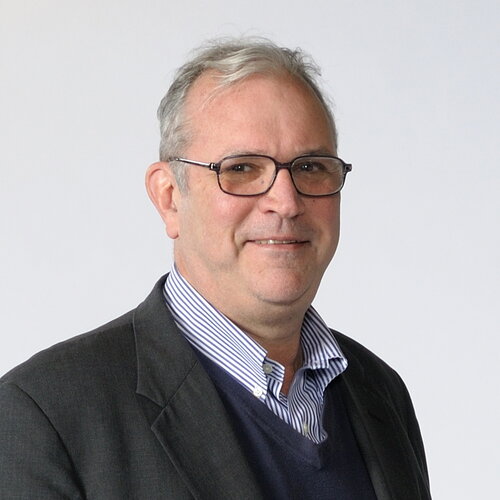
Contact Information
University of Illinois
A328 CLSL, Box 12-6
600 South Mathews Avenue
Urbana, IL 61801
Research Areas
Biography
Professor Thomas B. Rauchfuss received his undergraduate degree from the University of Puget Sound (1971) and his Ph.D. from Washington State University (1976). He has studied overseas at the following institutions: the Australian National University, University of Auckland, University of Strasbourg, and the Technical University of Karlsruhe. He is interested in all aspects of the synthesis and reactivity of inorganic, organometallic, and main-group compounds and materials.
Research Interests
synthetic organometallic and inorganic chemistry applied to biomimetic catalysis, ion separation, and dihydrogen activation
Research Description
We are interested in all aspects of the synthesis and reactivity of inorganic, organo-metallic, and main-group compounds and materials.
A major interest for our group is environmentally-motivated organometallic chemistry. We are interested in fundamental studies leading to clean fuels. One aspect of this research is the elucidation of nature's methods for making H2, which involves the use of unusual enzymes called hydrogenases. Weworking to simulate a range of structural and reactivity features of these enzymes. These studies include classical organometallic approaches as well as collaborative efforts involving the proteins. An emerging area of interest is the biosynthesis of the active sites. Other interests include the role of metals in nitrogen fixation, carbonylation enzymes, and methanogenesis.
Because most energy is generated from petroleum, we are interested in new catalysts for removing sulfur from this feedstock. Fundamental issues include the detailed mechanisms of C—S bond cleavage (to separate the sulfur from the organic matrix) and the synthesis of novel compounds as catalysts. A key aspect of C—S bond cleaving reactions is the role of H2. One can appreciate that studies on bioinorganic and industrial chemistry overlap significantly, and we feel there are important lessons to be exchanged between these otherwise disparate themes.
An area of past interest is the design of organometallic boxes, bowls, and tubes. These fundamental structures represent the ultimate nanoscale containers, but rational routes for their synthesis remains a frontier of synthesis. Representative products of this effort are a rhodium-containing bowl based on seven Rh atoms interconnected by nine cyanides, molecular boxes with metals at the corners. The molecular boxes selectively bind alkali metals (at their center) such that the binding of Cs+ is favored over the binding of K+ by more than 104-fold. This selectivity illustrates the advantages of the rigid frameworks versus the usual organic heterocyclic ligands. We are making progress in the synthesis of electroactive cages for sensors and in understanding and controlling the cage assembly processes.
Awards and Honors
Award for Distinguished Service in the Advancement of lnorganic Chemistry (ACS), 2018
Ronald Nyholm Prize (Royal Society of Chemistry), 2014
Fellow American Chemical Society, 2009
Award in Inorganic Chemistry (ACS), 2002
Fellow Royal Society of Chemistry, 2000
Senior U.S. Scientist Award (Alexander von Humboldt Foundation), 1998
Fellow Japan Society for the Promotion of Science, 1997
Guggenheim Fellowship, 1991
Alfred P. Sloan Fellowship, 1983
Camille and Henry Dreyfus Teacher-Scholar Award, 1982
Union Carbide Innovation Award, 1981
Additional Campus Affiliations
Larry R. Faulkner Professor Emeritus, Chemistry
Research Professor, Chemistry
Honors & Awards
Award for Distinguished Service in the Advancement of lnorganic Chemistry (ACS), 2018
Ronald Nyholm Prize (Royal Society of Chemistry), 2014
Fellow American Chemical Society, 2009
Award in Inorganic Chemistry (ACS), 2002
Fellow Royal Society of Chemistry, 2000
Senior U.S. Scientist Award (Alexander von Humboldt Foundation), 1998
Fellow Japan Society for the Promotion of Science, 1997
Guggenheim Fellowship, 1991
Alfred P. Sloan Fellowship, 1983
Camille and Henry Dreyfus Teacher-Scholar Award, 1982
Union Carbide Innovation Award, 1981
Highlighted Publications
Rauchfuss, T. B. (2015). Diiron Azadithiolates as Models for the [FeFe]-Hydrogenase Active Site and Paradigm for the Role of the Second Coordination Sphere. Accounts of chemical research, 48(7), 2107-2116. https://doi.org/10.1021/acs.accounts.5b00177
Reijerse, E. J., Pham, C. C., Pelmenschikov, V., Gilbert-Wilson, R., Adamska-Venkatesh, A., Siebel, J. F., Gee, L. B., Yoda, Y., Tamasaku, K., Lubitz, W., Rauchfuss, T. B., & Cramer, S. P. (2017). Direct Observation of an Iron-Bound Terminal Hydride in [FeFe]-Hydrogenase by Nuclear Resonance Vibrational Spectroscopy. Journal of the American Chemical Society, 139(12), 4306-4309. https://doi.org/10.1021/jacs.7b00686
Schilter, D., Camara, J. M., Huynh, M. T., Hammes-Schiffer, S., & Rauchfuss, T. B. (2016). Hydrogenase Enzymes and Their Synthetic Models: The Role of Metal Hydrides. Chemical reviews, 116(15), 8693-8749. https://doi.org/10.1021/acs.chemrev.6b00180
Recent Publications
Rao, G., Tao, L., Yu, X., Rauchfuss, T. B., & Britt, R. D. (2025). The Radical S-Adenosyl-l-methionine Enzyme HydE Forms an Fe(I)Fe(I) Dimer En Route to the [FeFe] Hydrogenase H-Cluster. Journal of the American Chemical Society, 147(36), 32737-32744. https://doi.org/10.1021/jacs.5c08533
Yu, X., Woods, T. J., & Rauchfuss, T. B. (2025). Characterization of Complex-B ([Fe(κ3-cys)(CN)(CO)2]−), Biosynthetic Precursor to the [FeFe]-Hydrogenase Active Site, and Related Complexes. Journal of the American Chemical Society, 147(30), 26762-26768. https://doi.org/10.1021/jacs.5c07540
Yu, X., Woods, T., Zhang, Y., & Rauchfuss, T. B. (2025). [Fe2(μ-S2)(CN)2(CO)4]2–, [Fe2(μ-SH)2(CN)2(CO)4]2–, and [Fe2(μ-SH)(μ-SCH2NH2)(CN)2(CO)4]2–Related to the Biosynthesis of the [2Fe]HSite of the [FeFe]Hydrogenases. Inorganic Chemistry, 64(43), 21526-21533. https://doi.org/10.1021/acs.inorgchem.5c03496
Yu, X., Woods, T. J., & Rauchfuss, T. B. (2025). Synthesis of [Fe2[(μ-SeCH2)2NH](CN)2(CO)4]2- and Related Iron Selenoates. Organometallics, 44(1), 307-314. https://doi.org/10.1021/acs.organomet.4c00457
Britt, R. D., Rauchfuss, T. B., & Rao, G. (2024). The H-cluster of [FeFe] Hydrogenases: Its Enzymatic Synthesis and Parallel Inorganic Semisynthesis. Accounts of chemical research, 57(14), 1941-1950. https://doi.org/10.1021/acs.accounts.4c00231